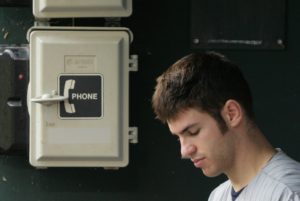Tout Wars decided to start a Head 2 Head game and I set about to create a challenging 12-team mixed game that would not rely on extreme distorting tactics (overloading on relievers or starters) to win. The result was:
The Rules:
5×5, $260, standard Tout Wars rosters (14 hitters, 9 pitchers).
Categories: R, HR, RBI, NET SB, OBP, W+QS, ERA, NET SV, K/9, WHIP
Each team would face each other team twice in 18 one-week contests and four two-week contests. Each contest would generate six games of Wins and Losses. The team that won the most Hitting categories would get two wins, the other two losses. Ties split the two. Same went for Pitching categories, and Overall. So in any contest you might go anywhere from 6-0 to 0-6, with each step in between possible, too. These contests would generate 132 wins and losses for each team.
But there would also be a roto contest going on. Teams would be ranked by 5×5 roto standings for the first half of the season (opening day to July 3 this year), the second half of the season, and the season as a whole. Each of the three parts would generate 11 wins or losses, so the first place team would go 11-0, the second place team 10-1, and so on. This would generate 33 more wins and losses, so each team would have 165 decisions, three more than a major league team.
There were minimum innings requirements for each half of the season and the season as a whole (450 each half, 900 for the whole).
Fairly late in the game I decided to play this game this year, rather than in Tout NL, because I had never played in a Head to Head league and thought I should take some of my my own medicine.
You can read my preseason comments about my team here.
 Long story short? I finished third, behind Jeff Zimmerman and Brent Hershey. But the highlight of my year was winning a side bet with Howard Bender, which resulted in this picture being splashed via social media all over the internet.
Long story short? I finished third, behind Jeff Zimmerman and Brent Hershey. But the highlight of my year was winning a side bet with Howard Bender, which resulted in this picture being splashed via social media all over the internet.
Here’s a link to the final standings. You’ll find the week-by-week results here.
The first thing that happened was that my main steals guy, Dee Gordon, was suspended and missed the first 80 games of the season. Still, I finished second in steals for the first half because Mike Trout was running and Wil Myers was running and I picked up Jose Ramirez after it looked like Brad Miller wasn’t going to play regularly and he was running. As was Paul Goldschmidt. So, steals weren’t a problem.
Hitting wasn’t a problem, all season, except for the week I lost 6-0 to Andrea LaMont, whose team was built around a strong pitching staff that didn’t perform. Along the way I picked up Aledmys Diaz and Jean Segura, in addition to Ramirez, and all produced in the cumulative and qualitative cats, and Trout, Goldschmidt, Manny Machado all stayed healthy and did their typically excellent jobs. Then reservist Trea Turner emerged and Dee Gordon returned and the offense got even stronger in the second half, even with Diaz missing a lot of time to injury, though by then I could have used Brad Miller back, for his power.
Net Saves became a problem. Jonathan Papelbon, Trevor Rosenthal and David Robertson did not endure. So I hovered in the middle of the pack, winning some weekly contests and losing others.
The biggest problem was that I had one ace. His name was Jake Arrieta and he was a monster in the first half. So was Taijuan Walker. Rich Hill and Trevor Bauer helped in the first half, but Kevin Gausman was inconsistent and hurtful, and Jared Eickhoff turned a fast start into a mess. Still, the bottom line was that my anchor kept the ship afloat, and I finished middle-up in all the pitching categories except W+QS.
The biggest problem came when my anchor went overboard in the second half, and my ship, er, pitching staff sank. Arrieta became inconsistent and in many weeks was a liability. Overall he had a 4.48 ERA in the second half and struck out barely more than seven batters per nine. Taijuan Walker was terrible when he was healthy enough to take the mound, and Rich Hill didn’t take the mound enough to compensate.
Saves continued to be a problem, too. I picked up Tony Watson and Brandon Maurer to replace the fallen Papelbon and Rosenthal, which worked for a while, but then they went down, too. I again finished in the middle of saves, but near or at the bottom of ERA and WHIP and in the middle in K/9.
The result was that I often lost the pitching categories in the H2H part of the game, which led to a lot of 4-2 and 3-3 weeks. Not good enough to catch Jeff Zimmerman and Brent Hershey, who soldiered on. I did wreck Hershey’s chances with a 6-0 victory over him in the penultimate H2H contest, but that’s no satisfaction.
Could I have done something different? In hindsight I should have traded either Dee Gordon or Trea Turner or Travis Jankowski or Wil Myers or Paul Goldschmidt for good starting pitching. I mean, how could I not? What I can is that I tried to shortly after Gordon returned, but got no interest then at all, and I have to admit that after a while I felt defeated. I didn’t see a way to catch the leaders, even though I wasn’t that far back. The problem had to do with K/9 as a category.
Looking for a starting pitcher, I needed one with a high K rate. But so, obviously enough, did everyone else. That’s because most starters with high K rates are productive pitchers in ERA and Ratio, too, and probably Wins and Quality Starts, as well. That makes them hugely valuable and pretty much irreplaceable. Especially given the innings minimum, because not only are you then losing a high K rate pitcher when you trade him, but you’re adding someone who hurts you in that category. You can’t sit on a lead, you’re likely to be actively undermining it. Not cool.
I’m not sure if this is a flaw, exactly, but it was a part of this year’s game. Alternatives are all problematic, which is how we ended up with the current rules. Doing away with the minimum innings requirement means starters have no value in the H2H part of the game. Changing to a cumulative stat, like K or K-BB robs relievers of most of their value. But I wonder if that is a bad thing? It may be in a 12-team league, but not in a larger deeper league. I’m not sure.
We’ll be having a discussion about that over the winter. What seems evident is that teams that spent less on pitching finished in the top three positions (Howard Bender spent less, too, but had the misfortune of ending up with Sonny Gray and Gerrit Cole as his aces).
We’ll also evaluate whether going to Net Saves and Steals was a good thing, or if it just complicated things unnecessarily. What Net Saves did was undermine the value of non-closing relievers, because they tend to blow more saves than they get actual chances to earn them.
And finally, we’ll look at the hybrid H2H/Roto structure. It made a difference. Brent Hershey’s team won the roto standings all three parts of the season, while Jeff Zimmerman’s team finished second and I finished third. Zimmerman adapted after finishing tied for first in H2H the first half and won the H2H handily in the second half. Similarly, Jake Ciely’s team edged mine in H2H both halves, but I was able to overtake him because of the roto games. Since the advantage seems to have gone both ways, to the H2H play in the Zimmerman case, and to the Roto play in my case, maybe there is something to this.
The biggest problem was incorporating the roto standings into the website. If we can come up with a better way we’ll probably get rid of the roto part. Or not. It’s all up for review.
What I know is that this was a fun and challenging game to play and follow along with (though I’m not sure whether Doug Anderson and Andrea LaMont feel the same way).
 Last year, I dumped Joe Mauer, saved some money and improved the team.
Last year, I dumped Joe Mauer, saved some money and improved the team.




